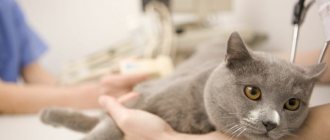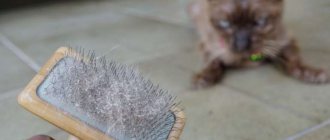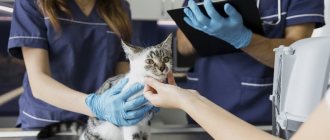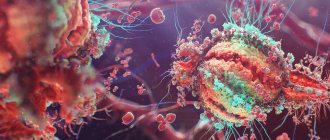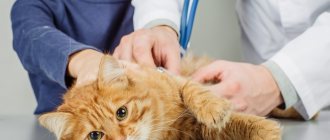Unfortunately, not all interactions we have with our cat are head-banging and comfortable naps. As guardian cats, we have responsibilities that require a little more privacy. Monitoring our cat's health means monitoring every part of her. Since parasites and gastrointestinal problems are relatively common in cats, it is important to check their anal health. We cannot communicate verbally with cats, so we must observe physical symptoms and behavioral changes to assess their health.
If you see your cat leaking fluid from her anus , you wonder what could be to blame. HowMeow.com analyzes the different types of fluid that may be coming from your cat and links the various causes that may be present.
What fluid is coming from my cat's anus??
While we must be vigilant in caring for our cat's health, it is important to recognize the symptoms of the condition and what may be a relatively common occurrence. This is why we need to observe the different types of fluid that may be coming out of your cat's rear end. Here are some of the possible colors, along with their likely source:
- Brown Fluid If your cat has brown fluid from the rectum, it is likely due to diarrhea. The causes of diarrhea vary, but most cases are related to diet. Since this is a symptom of many other conditions, it is important that you take them to the vet if it lasts more than 24-48 hours...
- Yellow Liquid Yellow liquid can also be part of diarrhea, but it can also be a sign that the cat has eaten something that has changed that color. However, if it is clear with a yellowish tint, it may be from the anal glands instead of the anus itself.
- Clear Fluid If you see clear fluid coming out of your cat's anus, it is likely due to your anal glands. If your cat is a little under the weather, then you may have some clear mucus coming from the anus. However, it could also be a sign of something more problematic, such as parasites, bacterial overgrowth, colitis, or even tumors, so you should contact your vet.
- Red Liquid If you see blood coming out of your cat's anus, then you should know that there are two main types. If it is bright red, then it is fresh blood and is likely coming from the anus itself. If it is dark red or brown, then it is overcooked and means that something is wrong in the gastrointestinal tract.
Prevention is always better than cure, so if you see a problem, you should take your cat to the vet for an evaluation. If they think it's a symptom of something more serious, they can run the appropriate tests...
Inflammation of the paraanal glands in cats: diagnosis and treatment
Inflammation of the paraanal glands in cats: treatment If a cat rides on the floor on its butt, licks or scratches it, then the cat may have inflammation of the paraanal glands.
Anal glands in cats
The paranal glands are two small sacs located on either side of the anus. These are sebaceous glands that produce an unpleasant-smelling liquid called secretion .
Why do cats need paraanal glands?
Cats use the secretions of their paraanal glands to mark their territory. A small amount of secretion is released when the cat goes to the toilet, adding a personal odor to the feces.
Causes of inflammation of the paraanal glands of cats
Inflammation and/or infection of the glands can be caused by a number of reasons. If the anal glands become full, the secretion becomes darker and the consistency becomes denser.
Bacteria that are normally found in stool can penetrate the glands. Typically, these bacteria are flushed back into the rectum during bowel movements. But if secretion is disrupted, bacteria can begin to multiply in the gland, causing inflammation. In this case, the discharge becomes bloody, and the cat's anal glands become filled with pus. An abscess develops. It looks like a swelling on one or both sides of the cat's anus. This swelling causes pain in the cat when pressed. If the abscess is left untreated, pressure in the anal gland will build up until the abscess ruptures through the skin, causing the anal gland to rupture. Pus can also spread to surrounding tissues, causing severe damage to surrounding tissues.
Symptoms of inflammation of the paraanal glands in cats
Symptoms depend on the severity and cause of the disease.
- The cat crawls its butt on the floor
- Cat licks/bites butt
- Discharge from the anal glands
- Seals on one or both sides around the anus
- With an abscess - purulent or bloody discharge from the opened “abscess”, next to the anus (see photo below)
Inflammation of the glands is painful and even a normally affectionate cat may scratch and bite when trying to examine the affected area under the tail.
In some cases, indigestion or diarrhea is observed 1-2 weeks before signs of inflammation of the paraanal glands appear in the cat.
If you notice similar symptoms in your cat, we recommend that you contact a veterinary clinic. 24-hour veterinary clinic Constellation in North-East Administrative Okrug, next to the VDNKh metro station.
Treatment of inflammation of the paraanal glands in a cat
Treatment usually involves cleaning the anal glands by emptying them. If there is an infection, antibiotics are prescribed. If an abscess or rupture occurs, surgery will be required. Most cats are given painkillers and antibiotics for a few days to relieve swelling and inflammation.
Can inflammation of the anal glands in cats be cured?
Recurrent disease of the paraanal glands is uncommon in cats. However, some overweight cats develop chronic inflammation. Obese cats have difficulty emptying their anal glands. For these cats, increasing the fiber content in their diet may be a solution. If a cat has inflammation of the glands several times, the diet does not help, the paraanal glands are removed surgically. Since domestic cats do not need to mark their territory, removing the anal glands will not negatively affect the cat's life.
Cats anal glands
A cat's anal glands, or anal sacs, are located on either side of the anus. They would be at five and seven on the clock. Since they are a gland that secretes fluid, it is used for two main purposes:
- Lubrication of stool to facilitate bowel movements.
- Create a unique scent that cats use to identify and mark territory.
They can be found by pressing on the anus area, but they are usually not very noticeable. If any, it may be due to inflammation or another cause of swelling. Because they contain a unique scent, it is not uncommon to see other cats smelling this area as a means of greeting.
When a cat defecates, the feces pushes the glands and causes them to secrete fluid . However, there are other circumstances that can cause the anal sphincter to contract, in turn compressing the anal glands and emptying them. An example is fear, such as what a cat might experience when visiting a veterinary clinic. When this happens, you may see a clear liquid coming out of your cat's anus...
Anal glands are affected in cats
The impact means that the anal gland canal is blocked and prevents its release. This causes the gland to fill with fluid and swell. It is usually not painful unless accompanied by infection. However, this will be inconvenient and will expand. If your cat has dark brown and thick fluid coming from the anus, the cat may be suffering from strokes .
Fluid in the gland accumulates because it cannot cleanse the glands properly or at all. This can happen because the cat's feces are too soft or small to put pressure on the glands. It may also be due to a foreign object or infection that is blocking the gland. The main way to solve this problem is to manually express the gland (see below). It is possible that the expression of the gland should continue for a short time until the underlying problem is resolved.
However, this is not the only way to treat anal gland blocks . It is necessary to make changes in lifestyle, especially those related to diet. You may need to add a little more fiber to their food to give them proper nutrition. All of this should be discussed with your veterinarian...
Possible reasons why a cat has bloody diarrhea
- There are several most common causes of bloody diarrhea in a cat:
- viral infections;
- helminths;
- protozoa;
- toxoplasmosis;
- foreign objects in the gastrointestinal tract;
- gastroenterocolitis;
- tumors of the stomach and intestines;
- allergic reactions;
- damage to the intestines or anus;
- poisoning with toxic substances.
Toxoplasmosis, as the reason that a cat has diarrhea with blood
This parasitic disease is caused by the microbe Toxoplasma gondii. Felines are the primary hosts of Toxoplasma. Most often, a cat becomes infected through raw meat of sick animals, eating rodents and birds.
Microbes develop in the cat’s intestines and are released into the external environment with his feces. This stage lasts two to three weeks. Other animals and humans become infected
when cysts enter their body orally.
In cats, toxoplasmosis occurs as a respiratory disease or gastrointestinal disorder. The animal becomes lethargic, loses appetite, and experiences frequent vomiting and diarrhea. After a short period of time, toxoplasmosis is suppressed by the immune system and goes into a “dormant” form. If the disease is acute, bloody , purulent discharge from the eyes , fever and symptoms of damage to the respiratory system appear: wheezing, cough, rhinitis, shortness of breath. Toxoplasmosis, which is severe, can kill a cat, as microbes invade the cells of many organs, causing tissue necrosis. Therefore, one should not delay in providing adequate treatment.
Worm infestations, a possible reason why a cat has bloody diarrhea
As the name suggests, there are a large number of diseases caused by various helminths (worms). There can be several ways of infection: through contaminated water, meat, by eating soil, and even through the air. A beloved owner can, without knowing it, bring helminth eggs on his clothes and infect an absolutely domestic cat that never roams anywhere.
- There are symptoms common to different types of helminthiases:
- dull coat
- lethargy, weakness of the animal
- diarrhea (mucus and blood may be present)
- purulent discharge from the eyes
- unpleasant odor from the mouth area
- hard, painful abdomen
- poor appetite or, conversely, increased appetite, but the cat still loses weight.
In order to quickly cure an animal, it is necessary to determine the type of parasite
and select an effective drug. Here you cannot do without the help of a veterinarian who will prescribe a set of examinations and anthelmintic drugs.
The cat has diarrhea with blood, the cause is foreign bodies
Cats are curious by nature and often strive to eat something inedible: pieces of foam rubber, toys, plastic bags, threads, needles, sausage wrappers, New Year's tinsel, etc. Sometimes these objects can pass painlessly, but there are cases that they cause intestinal obstruction with its acute symptoms: frequent vomiting, loss of appetite, weakness, pain in the abdomen and palpation of the abdominal cavity, constipation or diarrhea (sometimes with blood). This condition is fraught with the development of intestinal inflammation, intestinal necrosis, perforation of the mucous membrane and sepsis
. Most often, immediate surgery is required after diagnosis. Even if the obstruction is partial, and you observe only some of the symptoms, the cat eats and goes to the toilet, do not rely on chance, but show your pet to the doctor, because such symptoms can also appear in other serious diseases.
Gastroenteritis as a reason that a cat has bloody diarrhea
This is an inflammation of the intestinal mucosa, accompanied by symptoms of indigestion and intoxication of the body. Often it is not an independent disease, but only a symptom of the underlying one.
- Causes of gastroenteritismay act:
- viral and bacterial infections (distemper, colibacillosis, leptospirosis, salmonellosis, adenovirosis and others)
- feeding low-quality food, low-quality dry food
- poisoning from household chemicals or toxins
- taking certain medications
- individual intolerance to certain substances, for example, in food.
- Gastroenteritiscauses such Clinical signs, How
- refusal to eat or poor appetite in a cat
- elevated temperature
- vomit
- diarrhea with blood and mucus, very frequent
- colic - pain in the intestines
- dehydration of the body, which manifests itself in saggy skin, dull fur, sunken eyes
- the mucous membranes of the mouth and conjunctiva are pale, the paws and ears of the animal are cold
- weak pulse
When treating this pathology, it is necessary to eliminate the cause that caused the inflammation, as well as carry out symptomatic therapy that eliminates dehydration in the cat, vomiting and diarrhea. An important role is played by a special gentle diet, which must be maintained for at least a month after visible recovery.
Neoplasms of the digestive system that cause bloody diarrhea in cats
In cats, fortunately, they are rare, accounting for about 1% of cases of oncological processes. They occur mainly in old cats and are usually localized in the small intestine. Symptoms depend on the location of the tumor, its size and the stage of the disease. The animal loses weight, the stomach becomes swollen, hard and painful, sometimes constipation and defecation disorders occur, sometimes vomiting and diarrhea with blood, pale mucous membranes.
To make a diagnosis of cancer, a cat examination, a tumor biopsy and a stool test are required. If possible, preference is given to surgery followed by chemotherapy. Recovery directly depends on the type of tumor and stage of the disease.
Anal gland infection in cats
As we said earlier, damage is not the only reason why a cat's anal glands may not be working properly. Also known as sacculitis , anal gland infection in cats causes painful inflammation in one or both of the cat's anal glands. You should suspect an anal gland infection if your cat has clear or yellowish fluid, pus-like fluid, or even blood from the area. A veterinarian will be able to diagnose the problem and will likely prescribe antibiotics to treat...
Inflammation of a pair of anal glands in a cat
The paraanal glands in cats are paired exocrine glands located on both sides of the anus. The inner lining of the “sacs” contains a large number of sebaceous and apocrine glands. The secretion produced by the paraanal glands is thick, creamy, white, and sometimes light gray in color.
The exudate contains pheromones - odorous volatile substances that have a sharp, unpleasant odor. These secretions are used by cats to mark their territory, attract partners during mating, and recognize strangers.
The secretion from the paraanal glands is secreted by the cat in small quantities as a result of muscle contractions and intestinal peristalsis through a small canal. Naturally, the release of the “bag” occurs during defecation or during the “spraying” of secretions during defense, when applying territorial marks.
The secretion secreted by a cat makes the tail area around the anus fatter, facilitating the process of defecation.
When the paraanal glands become inflamed in a cat, the secretion produced by the glands stagnates; in advanced cases, an abscess occurs and a fistula forms.
Causes of inflammation of the paraanal glands in a cat.
Modern cats, living in comfortable home conditions, when they do not have the need to use the paraanal glands to protect themselves from potential enemies, have led to the fact that they have lost the natural ability to cleanse their paraanal glands.
Inflammation of the glands in a cat occurs as a result of the influence of a number of factors:
- Chronic diseases of the digestive system, which are accompanied by constipation (constipation in a cat) and constant diarrhea (diarrhea in a cat).
- Genetic predisposition.
- Systemic infectious diseases (feline chlamydia, feline panleukopenia, leptospirosis, etc.).
- Parasitic diseases (worms in cats).
- Physical inactivity, sedentary lifestyle in a city apartment.
- Obesity (diagnosis of obesity).
- Injuries to the anal area.
- Congenital narrowness of the excretory canals of the glands.
- Feeding liquid food, bones.
- Pregnancy (pregnancy in a cat).
Pathogenesis . The mechanism of development of inflammation of the paraanal glands in a cat is as follows:
First, there is a violation of the removal of secretions from the glands, as a result of which a large amount of secretion accumulates in the glands. The formed secretion thickens, which further prevents its release during bowel movements in the cat. From feces, conditionally pathogenic microflora enters the glands, which acquires increased virulence and begins to multiply quickly. The secretion becomes thick, dark brown in color and has a foul odor. If treatment is not started in a timely manner, an abscess will appear at the site of the gland. When the abscess “matures,” its purulent masses lead to rupture of the gland membrane and we get an abscess. This abscess subsequently develops into non-healing fistulas with exit into the lumen of the rectum or with exit into the anal area.
During the entire process of inflammation of a pair of anal glands, the cat experiences pain and itching in the anal area.
Clinical picture. The disease in cats is accompanied by inflammation in the preanal area. The cat constantly licks the area of the tail and anus; when moving, the tail is pressed tightly to the anus. Due to pain, the cat tries to move less, refuses active games, tries to lie down more, and gait is disturbed. When stroked in the tail area, it reacts painfully and shows signs of aggression. In order to release the secretion accumulated in the glands, it “rides” on the fifth point on the floor. The cat's tail takes on a greasy appearance. In advanced cases, we register an increase in body temperature.
When examining the anal area, veterinary specialists note swelling, swelling and redness of the tissues around the anus. When pressing on the paraanal glands, an unpleasant brown oily exudate is released from the anus.
a diagnosis of inflammation of the anal glands during a clinical examination of a sick cat by visually examining the anal area and assessing the amount and nature of the secretion. Using a napkin, the doctor squeezes the cat's paraanal glands and examines the released secretion - color, consistency, quantity. If necessary, the secretion is sent to a veterinary laboratory for culture to determine the type of pathogenic microflora and for subtitration of antibiotics.
Treatment . The basis of treatment of the disease in cats is the mechanical release of the paraanal glands from accumulated exudate. This procedure can be carried out using several methods. In the case when the secretion in the glands is liquid and has not hardened, then they can be cleaned externally.
To do this, the specialist, after disinfecting his hands, puts on surgical gloves and presses on the paraanal glands with sterile gauze swabs using the thumb and index finger.
If there are thick and viscous contents in the paraanal sinuses, veterinary specialists use an internal method to release the contents of the paraanal glands. In this method, wearing sterile gloves, an index finger is inserted into the cat's anus. The thumb massages the gland from the outside to stimulate secretion. Subsequently, a veterinarian uses a catheter to rinse them with antiseptic solutions. If indicated, the sick cat is prescribed antibacterial drugs (suppositories with anti-inflammatory effects). Depending on the severity of the inflammation, the manipulation must be repeated 2-3 times until the sacs are completely cleansed. With frequent relapses of the disease, surgery to remove the anal glands is recommended.
Prevention of the disease is based on preventing the development of inflammation of the paraanal glands. To this end, cat owners should:
- Eliminate causes of constipation and diarrhea in your cat.
- Treat chronic gastrointestinal diseases in a timely manner.
- Prevent anal injuries.
- Regularly (every three months) carry out preventive cleaning of the glands.
- Prevent your cat from becoming obese.
- Do not feed your cat foods that can cause injury to the mucous membrane of the rectum and anus (bones from fish and chicken).
- To prevent physical inactivity, conduct active and active games with your cat.
- Treat regularly against helminthic infestations.
- Vaccinate against infectious diseases existing in the region of residence (preparation of pets for vaccination and types of vaccines).
Abscess in a cat's anal gland
An infection may just be the beginning of the problem if our cat has problems with your anal glands . If our cat has fluid coming out of his anus, as described in the previous section, we should take a look at the gland itself. When the gland becomes red, then purple and enlarged, we may suspect that an abscess has formed. In these cases, devastation alone will not solve the problem. An anal gland abscess can grow so large that it breaks the skin and becomes a fistula, which can be very uncomfortable and painful for the cat.
The veterinarian will clean the area and prescribe antibiotics, but surgery . Although some people may fear that anal abscess in cats may be cancerous, it is important to remember that this is unlikely as carcinoma of the saccule accounts for[s]0.5% of all feline skin neoplasms .
How to express a cat's anal gland
If you see that your cat is licking her anal area a lot and is unable to release anal discharge properly, you may need to evaluate the gland yourself. However, although you may need to manually express the glands, it is best to go to the vet the first time so they can both show you how to do it correctly and make sure your cat is exposed to best practices first. This will help you express your cat's anal glands more easily.
Ideally, you will want someone to help hold the cat while her anal gland expresses. This is because it can be a very uncomfortable and even painful procedure. Once you have someone restraining the cat, you should lift the tail and look for the glands. For this procedure, it is better to wear rubber or latex gloves. Using your thumb and forefinger, grasp the individual gland and squeeze it towards the anus, where fluid usually comes out. You may want to leave the newspaper as the smell of the secretion can be quite unpleasant. The anal gland secretion should be brown, so if it is not, you should talk to your veterinarian.
Is this anal fluid?
If you see your cat losing fluid from the anal area, it is likely due to one of the above reasons. However, you must be very careful to correctly identify the source. In the case of women, we must ensure that the secretion comes from the anus and not from the vulva. If there is discharge that is pink, bloody, or contains pus, then it may be a reproductive problem. If your cat has not been spayed, she may be pregnant. However, such discharge can also be a sign of infection of the uterus or piometra . In any case, you should seek veterinary help immediately to determine the problem and find a course of treatment...
This article is purely informational. HowMeow.ru does not have the right to prescribe veterinary treatment or diagnose. We invite you to take your pet to the vet if you are suffering from any illness or pain.
Causes of discharge from the anus
Discharge in a cat during diarrhea or constipation is quite normal and quite common. They manifest themselves in different ways, but are fairly easy to identify, so they are not too dangerous. The owner may also notice a small amount of blood clots in them. This symptom disappears completely with complete recovery. Therefore, you should not worry too much about this.
But if the discharge from either the anus in a cat or the vaginal area in a cat is purulent or mucous in nature and has a characteristic odor, we can talk about the presence of an infection.
Often this can be associated with problems with the genital organs of cats. But there are other options that require careful testing, special tests and smears. Here you should seek the help of a specialist as soon as possible so as not to aggravate the situation and alleviate the cat’s suffering.
© shutterstock
Often the cause of discharge from the anus is inflammation of the paraanal glands. Previously, many were inclined to think that such problems were directly related to the abundant use of dry food in the diet of pets. However, it turned out that this is a myth. Often, discharge appears due to the unusual structure of the intestine itself . For example, you may notice frequent attempts by the animal to sit on its hind legs or walk along the floor. Such manifestations of attempts to get rid of excess secretions should be immediately noticeable to the owner.
